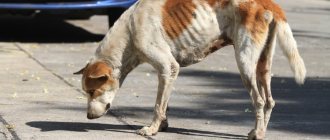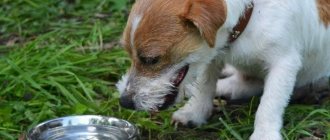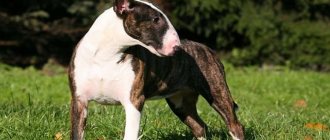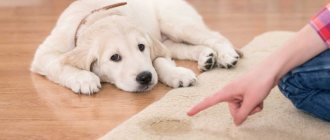The debate about whether it is worth feeding a dog with industrial food has not subsided for many years. One way or another, after assessing all the pros and cons, the choice is made only by the owner of the animal. If a positive decision is made, you need to know how to properly accustom your dog to dry food. Not all animals are happy to accept the initiative of their owners. In addition, if the process of switching to a different type of food is carried out incorrectly, the animal will find itself in a stressful situation, and the dog’s body will receive a colossal load.
How to accustom a dog to dry food
Advantages and disadvantages of industrial feeds
It’s not for nothing that industrial food is so popular among pet owners. High competition between manufacturers forces them to work over and over again to improve the quality of their products.
Industrial dog food
The result is the fact that it is now possible to select dry food that ideally meets all the needs of a particular breed, age and physical condition of the dog.
Some dog owners do not know or do not want to understand that their pets are not omnivores, and feed them inappropriate and sometimes harmful foods. This approach to feeding a dog sooner or later leads to disastrous health consequences, and in advanced cases can be fatal. Find out what you should not feed your dog in our separate article.
Convenience
One of the main advantages of dry food. Owners with busy schedules free up a lot of time that was previously spent on preparing healthy, natural food. Besides:
- There is no need for cooking.
- Dry food can simply be poured into a bowl.
- It takes no more than 15 minutes to feed your pet.
Reference! During this time, the dog manages to completely eat the prescribed portion of the treat.
Purity
Often, when feeding natural food, the dog is not too careful. The owner has to spend effort to clean up around the bowl, collecting pieces of food, and wash the pet. Residues of porridge or other products may end up not only on the dog’s face, but also on the ears and paws. This is especially true for animals with long hair.
When feeding dry food, the dog remains clean, and the cracker that falls out of the bowl does not stain the floor.
The food does not stain the dog’s fur or the floor around the bowl.
Benefit
Every responsible owner tries to make their pet’s food as healthy as possible. To do this, it is extremely important to calculate the ideal ratio of proteins, carbohydrates, vitamins and other components for the dog. In industrial feeds, all this is already contained in the quantity necessary for the life and health of the animal. No additional feeding is required.
Recommended composition of quality feed
These foods are formulated based on the dog's age, weight, and age. Some manufacturers produce food aimed at strengthening the immune system or solving certain animal health problems.
Reference! All of the above qualities refer to high-quality, high-class dry food. Cheap analogues most often do not have these qualities. They mainly consist of cereals and meat waste. Poor quality food will do more harm than good.
The disadvantages include the rather high cost of good dry food. Difficulties will also arise if the owner decides to change the brand and switch the dog to food from another manufacturer. A sudden transition may not have the best effect on your pet’s well-being.
Feeding rules when using industrial feed
Dry food consumption rates are usually highlighted in a separate block on the packaging. However, these figures are very approximate. The amount of feed required by each animal depends on many parameters. The main factors are the weight of the dog, its activity during the day and the energy value of drying.
Manufacturers offer a wide range of dry food
Economy class dry food usually has a poor composition. Accordingly, the dog requires a large portion to satisfy its hunger. In addition, such a diet implies the introduction of complementary foods containing substances necessary for the dog, which are not included in this drying.
Premium dry food is more balanced. They consist of protein components and include all the vitamins and microelements a dog needs.
To calculate the optimal amount of food for a dog, it is necessary to take into account that working animals, as well as lactating bitches, need an increased portion. For active dogs, the norm indicated on the package is increased by a third; for pregnant and lactating bitches, a quarter of the total recommended portion is added.
Proper feeding of a pregnant bitch is the key not only to her health, but also to the well-being of the entire litter after birth. You can read more about how to understand that a dog is pregnant in our separate article.
A pregnant dog needs more food
For older animals and those animals that lead a sedentary lifestyle, lying on the couch most of the day, it is advisable to reduce the portion by ¼. This will avoid overeating and, as a result, obesity.
According to statistics, about 40% of dogs are obese. Obesity is a condition in which excess fat is deposited in the subcutaneous tissue and other tissues. Dogs, like people, are also affected by this problem. You can read more about obesity in dogs in our special article.
Table 1. Recommended doses of premium food for different dogs.
| Dog weight | Amount of food per day for active dogs | Daily Value for Dogs with Low Activity Levels |
| 2 kg | 60 g | 30 g |
| 5 kg | 90 g | 60 g |
| 10 kg | 160 g | 120 g |
| 20 kg | 280 g | 180 g |
| 30 kg | 390 g | 240 g |
| 40 kg | 480 g | 320 g |
| 50 kg | 560 g | 360 g |
| 60 kg | 640 g | 420 g |
We should not forget about the feeding regime. The dog must eat strictly at the allotted time. If possible, you should avoid feeding during the day. This is especially true for food from the table. Human food contains too many spices and is absolutely not suitable for a dog's diet. In addition, such complementary foods disrupt the feeding schedule. As a result, when feeding time approaches, the dog simply will not eat because he does not feel hungry.
Special feeders make feeding even more convenient
Video - how to choose dry dog food
General recommendations for feeding your dog
Having made a choice in favor of a ready-made industrial composition for daily feeding of the pet, the owner must follow the recommendations of veterinary specialists and experienced dog breeders:
- The food must be of high quality. Cheap mass-market formulations, contrary to the properties stated on the packaging, do not provide the dog’s body with complete nutrients and contain a large amount of dyes, preservatives and synthetic flavor enhancers.
- The choice of one type of product or another depends mainly on the age and breed of the animal. We have developed our own line of food for puppies, and our own for adult pets. This gradation is associated with different needs for nutrients and minerals of young and already formed animals.
- The serving should not exceed that recommended by the manufacturer. The packaging contains approximate instructions for the dosage of food per day, based on its composition and the physiological needs of the dog’s body. Exceeding the recommended portion is strictly prohibited.
- Considering the complex process of digesting a dry product, the owner must clearly follow the basic rule - organize round-the-clock access for the pet to clean water.
- When feeding dry formula, it is important to adhere to the regimen. A puppy is fed 3-4 times a day, an adult dog - 2 times. The portions should be the same, not exceeding the daily requirement.
- You should not purchase a loose product. The seller cannot guarantee that opened large packages will be stored correctly. The risk of buying an overpriced product of poorer quality also increases. The best option is to purchase a whole package of the appropriate weight.
- Opened packaging should be stored in a dark and cool place, ensuring maximum sealing. Being in the light or in a warm room promotes rapid oxidation and spoilage of the product without visible changes.
Following simple rules and recommendations will allow the owner to avoid many problems with the pet’s health when using dry food.
We recommend reading about how to teach your dog commands. From the article you will learn how to train a dog to perform basic (voice, sit, lie down, place and others) and unusual commands.
And here is more information about how to train a dog to sit.
The decision to switch a dog to ready-made industrial formulations requires patience and consistency from the owner. The main condition for successful innovation is the gradual replacement of a familiar product in the diet with a new food. Following the recommendations of veterinary specialists will allow you to painlessly train both a puppy and an adult animal.
General rules for transferring to another diet
Switching a dog to a new type of food should not be immediate. This process takes from 1 to 3 weeks. During this time, the animal’s body has time to completely restructure itself to digest the new product.
When switching a dog to dry food, it is necessary to choose not only high-quality food, but also one that the dog will like. Often, the owner has to try dryers from several manufacturers before choosing the right one. Initially, it is best to buy a small amount of food to test.
Selecting the right food is a rather complicated process.
For a complete diet, only premium and holistic foods are suitable. When feeding them, the owner can be sure that the pet receives all the substances that ensure a normal life and good health. Some foods, like natural products, can cause allergies. If your pet develops a rash, itching or other allergic reactions, you should consult a veterinarian and purchase a dryer from a hypoallergenic line.
Constant access to water is a prerequisite when feeding dry food.
A dog eating dry food must drink a lot. Dry granules, unlike natural products, are practically devoid of moisture. The dog must have constant access to fresh water.
Reference! It is possible that the first time after changing the diet your pet will have to be walked more often. Over time, the body adapts and walking returns to its usual rhythm.
How to switch your dog to dry food
If the smell and sight of drying does not cause any desire in the dog to try it, you need to give the animal time to get used to it. To do this, a small amount of food (several granules) is placed directly next to a bowl filled with the pet’s usual food. After a few days, the dog will get used to the smell of drying and associate it with eating.
A little food near a bowl of familiar food will allow the dog to get used to its smell.
You can offer dry food as a treat during a walk. This will also give the dog time to get used to the new food.
Drying should be introduced gradually. In the first stages, the share of dry food should not exceed 10% of the total daily food intake. Then it is gradually increased. By the end of the first week of transfer, dry food should already make up 90-100% of the food.
Gradual increase in the proportion of dry food
If for some reason the animal does not want to eat the pellets, they are soaked in water or broth. Some dogs prefer mushy food. To soak the granules, take 2-3 parts of broth for 1 part of dry food. It is also permissible to use kefir or natural yogurt for this. When the drying percentage reaches 100%, you can offer the dog granules in dry form. Usually by this time she is completely accustomed to the new food.
Reference! For those dogs that have been fed wet industrial food, the granules are soaked in gravy.
Dogs accept soaked food better.
The procedure for transitioning a puppy to dry food is not too different from an adult dog. In this case, it is important not to forget that for the first 10 days after the puppy is taken from its mother, it should be fed with its usual foods. After the adaptation period has passed, you can gradually transfer the animal to dry food.
Reference! For puppies, there is a separate line of dry food, created taking into account the needs of a growing body.
When to do it
The owner, as a rule, is puzzled by the issue of accustoming a new family member to dry food already when the puppy appears in the house. Many dog breeders choose ready-made industrial food to feed their four-legged friends. This choice is due to several factors. First of all, dry mixes are convenient. You can take the food with you on the road, it does not spoil, and you do not need to waste time preparing the next portion.
Premium and super-premium food is a complete diet and does not require the use of multivitamin supplements. In the lines of well-known manufacturers there are a variety of foods intended for a specific age, breed, and physiological state. Medicinal specialized dry mixtures are also available for sale.
When deciding to feed a puppy dry food, the owner should know a few things. Experienced dog breeders recommend that during the first two weeks of your baby’s stay in a new home, you should not attempt to change his diet. During this period, the new family member is fed with foods familiar to him. Such a competent approach will allow the puppy to quickly adapt to new conditions without harm to health.
After the baby gets used to its environment, the owner can gradually begin accustoming him to dry food. Veterinary experts recommend using only high-quality premium and super-premium food for feeding puppies, designed specifically for young animals.
We recommend reading about how to train your dog to use a leash. From the article you will learn about the age at which a dog should be taught to use a leash, and the owner’s rules of behavior during training.
And here is more information about how to play with a dog.
Why does a dog refuse dry food?
As a rule, dogs eat delicious crackers with pleasure. Manufacturers, in the process of creating a new line of food, ensure that its taste and smell meet the preferences of four-legged friends. In this case, it happens that the dog categorically refuses to eat dry food. This behavior can be due to a number of reasons:
- satiety;
- habit;
- stress;
How to eliminate chronic stress in a dog
- oral diseases;
- improper storage;
- sedentary lifestyle;
- spoiled;
- graft;
- wrong translation.
An excessively large portion of food may cause the dog to refuse to eat at the next feeding. For normal functioning of the body, dry food requires significantly less than natural products.
Too large a portion leads to frequent refusals to eat
An animal that has been fed natural foods for most of its life may consider unusual pellets with an unusual smell to be unacceptable food. The dog should be introduced to dry food gradually, giving it the opportunity to adapt to unusual food.
Reference! Small dog breeds are often picky eaters. This is largely due to the fact that they regularly receive pieces of various delicacies from the master's table.
Unlike natural products, dry food is harder. If the dog has any wounds in the mouth or dental problems, chewing the dryer will cause pain to the pet.
Damage to the oral cavity is one of the reasons for refusing solid food
Dry food may go to waste if stored improperly. It develops an unpleasant smell and taste. A dog will not eat anything that can cause harm to its body. The same applies to economy class dry food with an unbalanced composition.
Animals whose day is spent mostly on the couch do not expend the required amount of energy. The consequence of this lifestyle is often apathy and loss of appetite.
A dog's sedentary lifestyle can cause a decrease in appetite.
Refusal to eat can be caused by transporting the dog to a new place or the absence of the owners. In such situations, the animal experiences severe stress, which provokes loss of appetite.
Vaccinations are required for your pet. They allow you to protect it from the most common diseases. In this case, the side effects of the injection are often nausea and lack of appetite.
Vaccination protects against infections that can lead to the death of the animal. These include several diseases, in particular rabies and leptospirosis, which are also dangerous to humans. But the dog owner does not always have the opportunity to visit a veterinary clinic. You can find out how to vaccinate your dog yourself in our separate article.
When switching your dog to dry food or even dry food from another manufacturer, you need to strictly follow the rules. If the principle of consistency is violated, the animal may develop a persistent aversion to this kind of food, which will not be easy to overcome in the future.
Reasons for pet refusal
The reasons for a dog’s refusal of dry food always lie in the physiological characteristics of its body, previous gastronomic experience, or the presence of certain health problems. If an animal does not want to eat dry granules due to the “fault” of the owner, this means that:
- the dog previously ate natural food and the new food is simply unfamiliar to it;
- the owner tries to quickly transfer the animal to a new brand, especially in the cheap segment;
- the pet is spoiled, which is often important for small dogs (the owners try to feed the pet something, as a result of which treats sometimes become the main food and snacking on cheese or pieces of meat leads to the refusal of less appetizing dry food);
- feeding the dog for a long time with the same type of food mixture, with periodic treats from the owner’s table.
Other objective reasons for ignoring a product include hot summer, irregular portions (drying consumption is always less than natural), spoilage or expired product, and its low quality.
If none of the above is suitable for a particular case, you should make sure that your pet is in good health and that there are no deviations in its health.
Health problems
A dog’s one-time refusal of a portion of granules does not indicate any problems in its health, of course, unless there are any other reasons to think about trouble. The reasons for contacting a veterinary clinic will be: refusal of water, general lethargy, vomiting or diarrhea. A variety of diseases, not always associated with the gastrointestinal tract, lead to similar symptoms. Thus, stomatitis often causes severe pain when the animal tries to chew dry granules, and inflammation of the gums, pharynx or esophagus makes it difficult to swallow food.
The symptoms of some ailments are more noticeable, while others are detected with a more thorough examination, but in any case, to make a final diagnosis, doctors will at least measure the dog’s body temperature and, if necessary, perform laboratory tests.
Important! In stressful situations, the normal option is to refuse food for 48 hours in the case of adult animals and about 24 hours in the case of puppies. If the hunger strike is prolonged, you should consult a veterinarian.
In addition to physical disorders, the reason for refusing dry food can be a psychological factor, for example, when the animal is under severe stress.
In most cases, it is associated with moving to a new place of residence, visiting a veterinary clinic, or bringing new pets into the home.
Males may not want to eat after meeting a female in heat while out for a walk, and females’ appetite often deteriorates during pregnancy or immediately after the birth of their offspring. There is no point in forcing them to eat food, because soon everything will return to normal.
What to do if your dog does not want to eat commercial food
First of all, it is necessary to exclude the disease of the animal. A sick dog will reject any food. If the reason for the refusal is diseases of the oral cavity, the pet should be shown to a veterinarian and appropriate treatment should be given. Until complete recovery, it is better to give the granules after soaking them in kefir or broth.
After the dog is completely switched to dry food, it is important to observe the intervals between feedings. Feed your pet at the same time. If the dog refuses to eat at the allotted hour, the bowl is removed after 15 minutes.
The dog refuses dry food
An animal can fast for 2-3 days without harm to the body. On the third day, the appetite usually returns and the dog eats the food offered with pleasure.
Important! During this period, it is necessary to completely eliminate handouts from the table and any complementary foods.
The dog must remember that it will receive only this food and only at the appointed time.
If your dog refuses to eat food that he has been eating for a long time, he may just need to change the taste. If your dog has eaten beef-flavored pellets, at the next feeding you can offer him the same brand of dry food, but with chicken or fish flavor.
Sometimes the best appetite stimulant is a long walk and active games in the fresh air.










